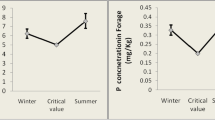Summary
Concentrations of serum copper were significantly lower in penned Najdi sheep (zero grazed) than in grazing sheep in eastern Saudi Arabia. Soil-plant-animal interrelationships studies suggest that this could be attributed to the low copper to molybdenum ratio in the forages (berseem and Rhodes grass) fed to the penned sheep as compared to pasture plants. This was in line with the status of these minerals in the soils.
Résumé
Les concentrations sériques du Cu ont été significativement plus basses chez les moutons Nadji maintenus en enclos que chez ceux admis au pâturage. Des études sur la relation sol-plantes-animal donnent à penser que cette situation pourrait être due au faible taux cuivre-molybdène dans les fourrages (Berseem × Rhodes grass) par rapport à celui des plantes des pâturages qui se trouvaient être du même ordre que ceux des sols, pour la teneur en ces deux minêraux.
Resumen
La concentratión de cobre sérico fue significativamente menor in ovejas Najdi estabuladas, que en ovejas en pastoreo. La relación suelo-planta-animal sugiere, que el fenómeno peude atribuirse, al bajo contenido de cobre en el alimento (berseem y pasto Rhodes) suministrado a los animales estabulados, en relación con el adquirido por los animales en pastoreo.
Similar content being viewed by others
References
Ali, K. E. & Othman, A. (1985). Copper status in four breeds of sheep in Saudi Arabia. Saudi Biological Society 8th Symposium on the Biological Aspects of Saudi Arabia, King Faisal University, Al-Ahsa. Abstracts. p 190.
Ali, K. E. & Al-Noaim, A. A. (1989).Mineral status of indigenous sheep of Saudi Arabia under intensive system. Saudi Biological Society 12th Symposium on the Biological Aspects of Saudi Arabia, King Saud University, Riyadh. Abstracts. p. 139.
A.O.A.C. (Association of Official Analytical Chemists) (1980).Official Methods of Analysis. 13th edn. Washington, D.C. pp. 31, 37, 38.
Chamberlain, A. G. &Clarke, S. H. (1981).Journal of Agricultural Science, Cambridge,97, 213–220.
Fick, K. R., McDowell, L. R., Miles, P. H., Wilkinson, N. S., Funk, J. D. & Conrad, J. H. (1979).Methods of Mineral Analysis for Plant and Animal Tissues. 2nd edn. University of Florida, Animal Science Department. pp 301–305.
Fiskell, J. G. A. (1965).Methods of Soil Analysis. (Ed. C. A. Black), American Society of Agronomy, Madison, pp. 1078–1083.
Kaneko, J. J. (1989).Clinical Biochemistry of Domestic Animals. 4th edn. (Ed. J. J. Kaneko). Academic Press, New York. pp 886–887.
Keen, C. L. &Graham, T. W. (1989).Clinical Biochemistry of Domestic Animals. 4th edn. (Ed. J. J. Kaneko). Academic Press, New York, pp. 757–764.
Lindsay, W. L. &Norvell, W. A. (1978).Soil Science Society American Journal,42, 421–428.
McDonald, P., Edwards, R. A. &Greenhalgh, J. F. D. (1982).Animal Nutrition. 3rd edn. Longman, London and New York. 335, 446.
McDowell, L. R., Conrad, J. H. & Ellis, G. L. (1983). Mineral deficiences and imbalances and their diagnosis. Paper presented at Symposium on Herbivore Nutrition in Sub-Tropics and Tropics—problems and prospects. Pretoria, South Africa. pp 10–11.
Migahid, A. M. (1978).Flora of Saudi Arabia. 2nd edn. Riyadh University Publication.
Perkin-Elmer (1982).Analytical Methods for Atomic Absorption Spectrophotometry. Norwalk, Connecticut, USA. pp BC-5, 26, 29, 30.
Reiseneuer, H. M. (1965).Methods of Soil Analysis. (Ed. C. A. Black). American Society of Agronomy, Madison, USA. pp 1050–1054.
Snedecor, G. W. &Cochran, W. G. (1967).Statistical Methods. 6th edn. Iowa State University Press, Ames, Iowa, USA.
Underwood, E. J. (1971).Trace Elements in Human and Animal Nutrition. 3rd edn. Academic Press, New York. pp 67–69.
Author information
Authors and Affiliations
Rights and permissions
About this article
Cite this article
Ali, K.E., Al-Noaim, A.A. Copper status of Najdi sheep in eastern Saudi Arabia under penned and grazing conditions. Trop Anim Health Prod 24, 115–120 (1992). https://doi.org/10.1007/BF02356955
Accepted:
Issue Date:
DOI: https://doi.org/10.1007/BF02356955




